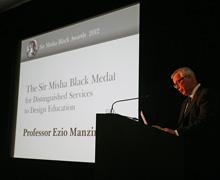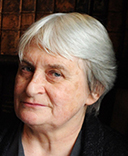Sir Misha Black Medal for Distinguished Services to Design Education
Professor Jeremy Myerson, Director of the Helen Hamlyn Centre for Design at the RCA, read the citation for Professor Ezio Manzini:
“It’s my great pleasure to introduce the recipient of the 2012 Sir Misha Black Medal for Distinguished Services to Design Education, and to say a little bit about why Ezio Manzini is such a worthy winner.
Italy may be the land of elegant, mass-produced design, but Ezio Manzini is most definitely a one-off.
We can describe him as a designer, engineer, architect, author, and outstanding educator. And all of those things are true – a real renaissance man. But above all else, he is one of the most important critical thinkers in design today.
Our constant guide through globalisation, our chief interpreter of how the world is changing, and our design conscience on making it a better place. In keeping with the sinuous shapes of Italian design, Ezio’s academic career has followed a kind of seductive S-bend.
He first came to international prominence as Professor of Industrial Design at the Polytechnic of Milan in the 1980s, talking about the Surface of Things – who could forget his memorable book, The Material of Invention, an indispensible primer for product designers everywhere? Then in the 1990s came Strategic Design, followed in the new millennium by a focus on Service Design, Sustainability and Social Innovation. So, all the S’s. Where Ezio leads, the rest of us follow. You could say he’s always ahead of the S-curve. Today he’s particularly interested in social innovation as a driver of sustainable changes, and in what design can do to support it. That’s why he coordinates DESIS, an active network of design schools around the world working in the fields of sustainable design and social innovation. A great initiative – and we don’t want him to desist from that! Ezio describes social innovation as ‘driven by diffuse creativity and entrepreneurship, resources that are very abundant in a densely populated and highly connected world – but only if we have the courage to recognise and use them.’
That message about creativity and entrepreneurship he has given to generations of design students, not only in Milan, but all around the world, and especially in China where his influence is now keenly felt. From the San Siro to Shanghai, from the Domus Academy, where he was once director, to Tongji, Ezio Manzini is now carrying the torch for a whole new type of socially engaged design. One capable of ‘scaling down’ to meet real local needs as well as ‘scaling up’ to address big global challenges.
It’s fitting, I think, that Ezio should received the Misha Black Medal in 2012 – on the 40th anniversary of the English language publication, by Thames and Hudson, of Victor Papanek’s Design for the Real World. Papanek’s book opened, if you may remember, with the incendiary statement, ‘There are professions more harmful than industrial design, but only a very few of them.’
Papanek then went on:
‘Before (in the good old days) if a person liked killing people, he had to become a general, purchase a coal mine, or else study nuclear physics. Today industrial design has put murder on a mass-production basis.
By designing criminally unsafe automobiles that kill or maim nearly one million people around the world each year, by creating whole species of permanent garbage to clutter up the landscape, and by choosing materials and processes that pollute the air we breath, designers have become a dangerous breed.
And the skills needed in these activities are taught carefully to young people.’
I think that Ezio Manzini’s whole career as an educator has been to make sure that industrial designers do not kill, maim or pollute – that designers take responsibility for their actions and that they are true to their own creativity and entrepreneurial spirit…
That is a fantastic achievement, sustainable in the best sense of the word, and I can think of no better recipient of the 2012 Sir Misha Black Medal.”
Photograph copyright ©Misha Black Awards/Joanna Piotrowska

Helen Hamlyn Centre




